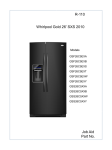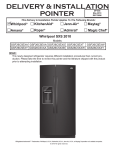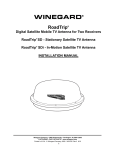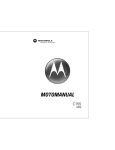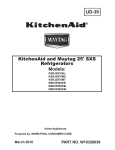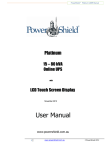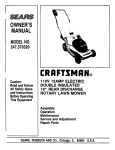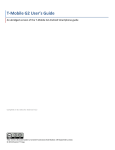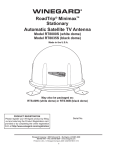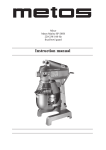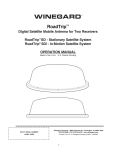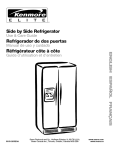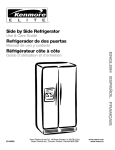Download Whirlpool GSS26C5XXB Specifications
Transcript
R-110 TECHNICAL EDUCATION 2010 Whirlpool 26’ SXS Refrigerators GSF26C5EXW GSF26C5EXY GSS26C5XXA GSS26C5XXB GSS26C5XXW GSS26C5XXY GSF26C5EXS GSF26C5EXT JOB AID W10338921 FORWARD This Job Aid, Whirlpool Gold 26’ SXS 2010 Part Number W10330404 has been compiled to provide the recent information on design, features, operation, troubleshooting and repair procedures for 26’ SXS for 2010. This Job Aid is not intended to replace or substitute for the Use and Care Guides or Tech Sheets associated with any of the models covered. Refer to the Technical Service sheet shipped with the refrigerator for detailed information for the unit you are servicing. GOALS AND OBJECTIVES The goal of this Job aid is to provide basic information that will enable the service technician to properly diagnose malfunctions and repair 26” SXS refrigerators for 2010. The objectives of this Job Aid are to: • Understand and follow proper safety precautions. • Successfully troubleshoot and diagnose malfunctions. • Successfully perform necessary repairs. • Successfully return the refrigerator to its proper operational status. Specific components and procedures covered in this Job Aid are: Grille Removal Leveling Door Alignment Door Removal Small 6 Cube Ice Maker Dispenser Thermistors Air and Water Filters Evaporator Fan Defrost Heater Defrost Bimetal Overload Protector Condenser Fan Motor Start Module Stealth Control WHIRLPOOL CORPORATION assumes no responsibility for any repairs made on our products by anyone other than authorized In-Home Service Professionals. Copyright © 2010, Whirlpool Corporation, Benton Harbor, MI 49022 - ii - TABLE OF CONTENTS Page GENERAL . . . . . . . . . . . . . . . . . . . . . . . . . . . . . . . . . . . . . . . . . . . . . . . . . . . . . . . . . . . . . . . 1-1 Safety. . . . . . . . . . . . . . . . . . . . . . . . . . . . . . . . . . . . . . . . . . . . . . . . . . . . . . . . . . . . . . . . . 1-1 Introduction Specifications and Overview. . . . . . . . . . . . . . . . . . . . . . . . . . . . . . . . . . . . . 1-2 SxS Model Number Interpretation. . . . . . . . . . . . . . . . . . . . . . . . . . . . . . . . . . . . . . . . . . . 1-3 6th Sense Technology. . . . . . . . . . . . . . . . . . . . . . . . . . . . . . . . . . . . . . . . . . . . . . . . . . . . 1-4 INSTALLATION REQUIREMENTS . . . . . . . . . . . . . . . . . . . . . . . . . . . . . . . . . . . . . . . . . . . . 2-1 Installation Instructions . . . . . . . . . . . . . . . . . . . . . . . . . . . . . . . . . . . . . . . . . . . . . . . 2-1, 2-7 REFRIGERATOR COMPONENTS . . . . . . . . . . . . . . . . . . . . . . . . . . . . . . . . . . . . . . . . . . . . 3-1 Disassembling Refrigerator Compartment Components. . . . . . . . . . . . . . . . . . . . . . . . . . 3-1 Disassembling Refrigerator Compartment Components –Water Filter Housing. . . . . . . . 3-3 Refrigerator Thermistor . . . . . . . . . . . . . . . . . . . . . . . . . . . . . . . . . . . . . . . . . . . . . . . . . . . 3-4 Accessing Water Reservoir. . . . . . . . . . . . . . . . . . . . . . . . . . . . . . . . . . . . . . . . . . . . . . . . 3-6 FREEZER COMPARTMENT AND ICE MAKER . . . . . . . . . . . . . . . . . . . . . . . . . . . . . . . . . . 4-1 Freezer Components. . . . . . . . . . . . . . . . . . . . . . . . . . . . . . . . . . . . . . . . . . . . . . . . . . . . . 4-1 Checking the Freezer Thermistor. . . . . . . . . . . . . . . . . . . . . . . . . . . . . . . . . . . . . . . . . . . . 4-1 Accessing Freezer Components . . . . . . . . . . . . . . . . . . . . . . . . . . . . . . . . . . . . . . . . 4-3, 4-4 Evaporator Component Identification. . . . . . . . . . . . . . . . . . . . . . . . . . . . . . . . . . . . . . . . . 4-4 Removing Evaporator Fan Motor. . . . . . . . . . . . . . . . . . . . . . . . . . . . . . . . . . . . . . . . . . . . 4-5 Checking evaporator Fan motor. . . . . . . . . . . . . . . . . . . . . . . . . . . . . . . . . . . . . . . . . . . . 4-6 Checking Defrost Bimetal. . . . . . . . . . . . . . . . . . . . . . . . . . . . . . . . . . . . . . . . . . . . . . . . . 4-7 Replacing the Defrost Heater. . . . . . . . . . . . . . . . . . . . . . . . . . . . . . . . . . . . . . . . . . . . . . . 4-8 Freezer Door Component Location. . . . . . . . . . . . . . . . . . . . . . . . . . . . . . . . . . . . . . . . . . 4-9 Ice maker – Emitter /Receiver Boards. . . . . . . . . . . . . . . . . . . . . . . . . . . . . . . . . . . . . . . 4-10 Component Identification. . . . . . . . . . . . . . . . . . . . . . . . . . . . . . . . . . . . . . . . . . . . . . . . . 4-12 Accessing New In Door Ice Maker. . . . . . . . . . . . . . . . . . . . . . . . . . . . . . . . . . . . . . . . . . 4-13 Ice Maker. . . . . . . . . . . . . . . . . . . . . . . . . . . . . . . . . . . . . . . . . . . . . . . . . . . . . . . . . . . . . 4-15 Modular Ice Maker & Ice Level Detector Service Sheet. . . . . . . . . . . . . . . . . . . . . . . . . 4-16 Disassembling the Ice Maker. . . . . . . . . . . . . . . . . . . . . . . . . . . . . . . . . . . . . . . . . . . . . . 4-17 Replacing Auger Motor and Related Components. . . . . . . . . . . . . . . . . . . . . . . . . . . . . . 4-19 Removing Auger Motor . . . . . . . . . . . . . . . . . . . . . . . . . . . . . . . . . . . . . . . . . . . . . . . . . . 4-20 Checking the Auger Motor. . . . . . . . . . . . . . . . . . . . . . . . . . . . . . . . . . . . . . . . . . . . . . . . 4-21 Removing Emitter and Receiver Boards . . . . . . . . . . . . . . . . . . . . . . . . . . . . . . . . . . . . . 4-21 Water Tube Routing. . . . . . . . . . . . . . . . . . . . . . . . . . . . . . . . . . . . . . . . . . . . . . . . . . . . . 4-22 DISPENSER AND USER INTERFACE . . . . . . . . . . . . . . . . . . . . . . . . . . . . . . . . . . . . . . . . . Programming. . . . . . . . . . . . . . . . . . . . . . . . . . . . . . . . . . . . . . . . . . . . . . . . . . . . . . . . . . . Stealth Control. . . . . . . . . . . . . . . . . . . . . . . . . . . . . . . . . . . . . . . . . . . . . . . . . . . . . . . . . . Sleep Mode . . . . . . . . . . . . . . . . . . . . . . . . . . . . . . . . . . . . . . . . . . . . . . . . . . . . . . . . . . . . Adjusting Temperature Set Points. . . . . . . . . . . . . . . . . . . . . . . . . . . . . . . . . . . . . . . . . . . Adjusting Temperature Settings. . . . . . . . . . . . . . . . . . . . . . . . . . . . . . . . . . . . . . . . . . . . . Freezer Temperature Setting. . . . . . . . . . . . . . . . . . . . . . . . . . . . . . . . . . . . . . . . . . . . . . . Ice Dispenser. . . . . . . . . . . . . . . . . . . . . . . . . . . . . . . . . . . . . . . . . . . . . . . . . . . . . . . . . . . Max Ice. . . . . . . . . . . . . . . . . . . . . . . . . . . . . . . . . . . . . . . . . . . . . . . . . . . . . . . . . . . . . . . Dispenser Light . . . . . . . . . . . . . . . . . . . . . . . . . . . . . . . . . . . . . . . . . . . . . . . . . . . . . . . . . - iii - 5-1 5-1 5-1 5-2 5-4 5-5 5-5 5-6 5-7 5-8 TABLE OF CONTENTS (continued) Door Open Alarm . . . . . . . . . . . . . . . . . . . . . . . . . . . . . . . . . . . . . . . . . . . . . . . . . . . . . . . 5-9 Dispenser Lock . . . . . . . . . . . . . . . . . . . . . . . . . . . . . . . . . . . . . . . . . . . . . . . . . . . . . . . . 5-10 Cooling Off Mode. . . . . . . . . . . . . . . . . . . . . . . . . . . . . . . . . . . . . . . . . . . . . . . . . . . . . . . 5-11 Cooling On Mode. . . . . . . . . . . . . . . . . . . . . . . . . . . . . . . . . . . . . . . . . . . . . . . . . . . . . . . 5-11 Water Filter Status Light. . . . . . . . . . . . . . . . . . . . . . . . . . . . . . . . . . . . . . . . . . . . . . . . . . 5-12 Showroom Mode . . . . . . . . . . . . . . . . . . . . . . . . . . . . . . . . . . . . . . . . . . . . . . . . . . . . . . . 5-13 Accessing User Interface and Dispenser Components. . . . . . . . . . . . . . . . . . . . . 5-14, 5-17 MACHINE COMPARTMENT . . . . . . . . . . . . . . . . . . . . . . . . . . . . . . . . . . . . . . . . . . . . . . . . . Machine Compartment Components. . . . . . . . . . . . . . . . . . . . . . . . . . . . . . . . . . . . . . . . . Starting Device Operation . . . . . . . . . . . . . . . . . . . . . . . . . . . . . . . . . . . . . . . . . . . . . . . . . Accessing Dual Water Valve . . . . . . . . . . . . . . . . . . . . . . . . . . . . . . . . . . . . . . . . . . . . . . . Condenser Fan . . . . . . . . . . . . . . . . . . . . . . . . . . . . . . . . . . . . . . . . . . . . . . . . . . . . . . . . . Drain Pan. . . . . . . . . . . . . . . . . . . . . . . . . . . . . . . . . . . . . . . . . . . . . . . . . . . . . . . . . . . . . . Front Wheel. . . . . . . . . . . . . . . . . . . . . . . . . . . . . . . . . . . . . . . . . . . . . . . . . . . . . . . . . . . . Control and Power Supply Boards. . . . . . . . . . . . . . . . . . . . . . . . . . . . . . . . . . . . . . . . . . . 6-1 6-1 6-3 6-4 6-5 6-6 6-7 6-8 DIAGNOSTICS, WIRING DIAGRAMS AND TROUBLESHOOTING . . . . . . . . . . . . . . . . . . 7-1 Voltage Test Points. . . . . . . . . . . . . . . . . . . . . . . . . . . . . . . . . . . . . . . . . . . . . . . . . . . . . . . 7-3 Thermistor Resistance Table . . . . . . . . . . . . . . . . . . . . . . . . . . . . . . . . . . . . . . . . . . . . . . . 7-6 Service Sheet. . . . . . . . . . . . . . . . . . . . . . . . . . . . . . . . . . . . . . . . . . . . . . . . . . . . . . . 7-7, 7-8 Product Specifications And Warranty Information Sources. . . . . . . . . . . . . . . . . . . . . . . . 7-4 - iv - GENERAL Safety Observe all safety warnings and messages. The Use and Care manual and Installation instructions that come with the product as well as stickers and literature attached to the refrigerator contain safety symbols. These symbols contain messages telling you of potential hazards and explain how to reduce your chance of injury. The message will also tell you what can happen if the instructions are not followed. Your safety and the safety of others are very important. We have provided many important safety messages in this manual and on your appliance. Always read and obey all safety messages. This is the safety alert symbol. This symbol alerts you to potential hazards that can kill or hurt you and others. All safety messages will follow the safety alert symbol and either the word “DANGER” or “WARNING.” These words mean: DANGER WARNING You can be killed or seriously injured if you don't immediately follow instructions. You can be killed or seriously injured if you don't follow instructions. All safety messages will tell you what the potential hazard is, tell you how to reduce the chance of injury, and tell you what can happen if the instructions are not followed. IMPORTANT SAFETY INSTRUCTIONS WARNING: To reduce the risk of fire, electric shock, or injury when using your refrigerator, follow these basic precautions: Use nonflammable cleaner. Plug into a grounded 3 prong outlet. Keep flammable materials and vapors, Do not remove ground prong. Do not use an adapter. such as gasoline, away from refrigerator. Do not use an extension cord. Use two or more people to move and install Disconnect power before servicing. refrigerator. Replace all parts and panels before operating. Disconnect power before installing ice maker (on ice maker kit ready models only). Remove doors from your old refrigerator. Use a sturdy glass when dispensing ice (on some models). SAVE THESE INSTRUCTIONS 1-1 Dimensions Inches. Introduction Specifications and Overview Capacity Dimensions Carton Depth Capacity Dimensions Carton Height Carton Depth Capacity Carton Width Carton Carton Height Depth Cutout Depth (in) Carton Height Width Carton Cutout Height (in) Cutout Depth (in) Carton Width Cutout Width (in) Cutout (in) Cutout Height Depth (in) Depth Cutout Cutout Width Height(in) (in) Height Depth Cutout Width (in) Width Height Depth Depth Closed Excluding Width Height Handles Depth Width Closed Excluding Depth Closed Including Handles Handles Depth Closed Excluding Depth Closed Including Handles Depth Excluding Doors Handles Depth Closed Including Depth With Door Open Depth Excluding Doors90 Handles Degree Depth Door Open Depth With Excluding Doors90 Gross Weight Degree Depth With Door Open 90 Height To Top Of Cabinet Gross DegreeWeight Height To HeightWeight To Top Top Of Of Door Cabinet Gross Hinge Height Height To To Top Top Of Of Door Cabinet Hinge Height To Top of Door Trim Height To Top Of Door Hinge Height To TopOpen of Door Width Doors 90 Trim Degrees Height To TopOpen of Door Width Doors 90 Trim Width of Cabinet Only Degrees Width Doors Open 90 Width with Doors Only Closed Width of Cabinet Degrees Capacity Width Doors Only Closed Width with of Cabinet Gross Weight Width with Doors Closed 26.360 26’ Dimensions Inches. 35 26.360 Inches. 71 1/4 35 26.360 38 71 35 1/4 29 13/16 38 71 1/4 69 5/16 29 38 13/16 36 1/16 69 29 5/16 13/16 36 36 69 1/16 5/16 69 1/4 36 36 1/16 35 69 7/16 1/4 36 35 33 7/16 1/2 69 1/4 35 33 7/16 1/2 36 33 1/2 36 29 3/8 36 29 7/8 3/8 50 29 3/8 50 2987/8 68 5/8 50 2987/8 68 15/16 5/8 68 298 68 68 5/8 15/16 69 1/4 68 15/16 69 1/4 37 3/4 69 1/4 37 7/16 3/4 35 35 37 35 3/4 7/16 26.360 C.F. 35 35 3/4 7/16 298 LBS. 35 3/4 1-2 1-3 Introduction Specifications and Overview (continued) 6th Sense Technology 6th Sense software makes an estimation of the actual food temperature inside the refrigerator and freezer compartment and adjusts cooling to allow the food packages to return their initial temperature faster during pull down, door openings, or heavy food load. 6th Sense algorithm runs in both freezer compartment and refrigerator compartment and each contains 3 routines: Trigger, Package Estimator, and Defrost Manager. Trigger routine is executed every 2.5 seconds while Package Estimator and Defrost Manager are executed every 10 seconds. The trigger routine is divided into two subroutines: door monitoring and temperature monitoring. Trigger parameters and performance parameters reside in the User Interface board, the actual 6th sense algorithm resides in Gemini Flash board. Package Estimator routine computes an estimation of food in FC and RC according to Thermistor reading and door status. Package estimator is run when the User Interface sends the required parameters to Gemini flash and sets the 6th Sense Enable bit to true. If 6th Sense is needed, it will call for additional cooling by turning on compressor, damper and evaporator fan. Defrost manager is composed of two main states: Normal and 6th Sense. When 6th Sense routine is active, defrost will be inhibited based on the control parameters settings to allow food temperature recovery. 1-4 INSTALLATION REQUIREMENTS Installation Instructions This new SXS platform requires different installation steps and adjustments than current SXS refrigerators. Review the Use and Care manual and instruction sheets shipped with the product prior to installation. See the following examples: Door Removal, Leveling and Alignment hex 2-1 Installation Instructions (continued) Installation - Example hex 2-2 Installation Instructions (continued) Installation - Example (continued) 2-3 Installation Refrigerators are shipped with the handles packed in the refrigerator door. 1. Remove the handles from the door and unwrap. 1 2. The instruction sheet and a Hex key tool are attached to the handle. Review the instruction sheet. 2 3. Install the handle on the mounting studs with the hex screws facing to the center. 3 4. Hold the handle tight against the door as you tighten the screws. The handle will pull in tight against the door as the screw is tightened. 4 2-4 Installation Instructions (continued) Installation (continued) Removing Grille WARNING Electrical Shock Hazard Disconnect power before servicing. Replace all parts and panels before operating. Failure to do so can result in death or electrical shock. 1. Disconnect power to the refrigerator. Remove 2 ¼” screws The grille is held in place with 2 ¼” screws. 2. Remove screws 2 Remove grille 3. Open the doors 90 degrees perpendicular to the cabinet to remove the grille. 3 Components Located Behind Grille Water Tubes Leveler Leg Center Roller Wiring Harnesses Leveler Leg 2-5 Installation Instructions (continued) Removing Freezer Door WARNING Electrical Shock Hazard Disconnect power before servicing. Replace all parts and panels before operating. Failure to do so can result in death or electrical shock. 2 1. Unplug or disconnect the refrigerator from the power supply. onnect water tubes form the de of the connector 2. Remove the screws securing the wire harnesses to the cabinet. 32 3. Disconnect water tubes form the door side of the connector. 4. Unplug the three wire harnesses plugged into the terminal board. 43 5. Remove strain relief from the wire harness. This will allow the harness to pass through the hole in the hinge. 5 2-6 Installation Instructions (continued) Removing Freezer Door Upper Hinge 6. Remove Two 3/16” hex key screws (A). Do not remove or loosen the other two screws (B). 7. Keep the door closed and lift off the hinge. B A A B 65 WARNING Excessive Weight Hazard Use two or more people to lift the freezer door. Failure to do so can result in back or other injury. Lift off the hinge 76 8. Have another person open the freezer door and lift up slowly. 87 9. As the door is lifted guide the wiring harnesses and water tubes through the hinge. 98 10. Lift the door straight up to prevent damage and kinking of the water tube. Note: When assembling, always use 2 people and make sure not to crimp the water tubes when installing through the hinge hole. 9 10 2-7 —NOTES— 2-8 REFRIGERATOR COMPONENTS Refrigerator Compartment Light Bulbs Air Damper Air Filter Water Filter Disassembling Refrigerator Compartment Components WARNING 2 1 Electrical Shock Hazard Disconnect power before servicing. Replace all parts and panels before operating. Failure to do so can result in death or electrical shock. 1. Disconnect power to the refrigerator. 32 2. Open the water filter door and remove the filter. 3. Open the air filter door and remove the filter. 4. Remove the ¼” screw securing the air damper cover to the cabinet. 43 3-1 Refrigerator Compartment (continued) 3 5. Remove the air damper cover. 54 6. Remove the ¼” screw securing the air filter housing to the cabinet and remove. 65 7. Disconnect the wiring harness and remove the air damper assembly. 76 8. Check the seal around the damper housing for any damage or misplace ment. Replace or reposition seal as needed. 87 3-2 Refrigerator Compartment (continued) Disassembling Refrigerator Compartment Components – Water Filter Housing Remove the water filter as explained earlier. 1. Remove the ¼” screw securing the filter cover to the filter body. 1 2. Remove the cover. 2 3. Remove the ¼” screw securing the filter body to the cabinet wall. 3 4. To replace the filter housing, disconnect the water tubes in the back of the refrigerator and remove Permagum seal. Pull the filter housing and water tubes through the opening in the cabinet and replace. 4 3-3 Refrigerator Compartment (continued) Refrigerator Thermistor The refrigerator Thermistor is a variable resistance device connected to the control board. The temperature of the refrigerator compartment causes the resistance of the Thermistor to change. The resistance is monitored by a circuit on the control board which controls the operation of the cooling system. The Thermistor is located on the right side of the refrigerator cabinet attached to the back of the cover labeled 6th sense. Refrigerator Thermistor WARNING Electrical Shock Hazard Disconnect power before servicing. Replace all parts and panels before operating. Failure to do so can result in death or electrical shock. 1. Disconnect power to the refrigerator. 2. Disconnect the wiring harness from connector P6 on the control board. 3. Connect an Ohmmeter across the Orange and Blue/White wires in the disconnected wiring harness and measure the resistance. 4. Compare the resistance measured to the value listed on the tech sheet shipped with the refrigerator. Replace Thermistor if needed. 3-4 Refrigerator Compartment (continued) Replacing Refrigerator Thermistor 1. Depress the tabs on either end of the Thermistor cover and remove. 2. To replace the Thermistor order replace ment Thermistor kit through the normal part ordering system by model number. Follow the instructions supplied with the kit. 1 2 3-5 Refrigerator Compartment (continued) Disassembling Refrigerator Compartment Components – Accessing Water Reservoir Disassembling Refrigerator Compartment Components – Accessing Water Reservoir 1. The light bulb cover is very flexible and can be bent to release the 4 tabs that extend into the cabinet wall and remove. 1 2. To replace the water reservoir, Shut off water supply. 3. Remove the ¼” hex head screw and the wire ties securing the reservoir to the cabinet. 3 2 4. Disconnect the water tube connected to the dual water valve located in the machine compartment and disconnect the water tube fitting on the lower left hand corner of the reservoir. Pull out the water reservoir and the water tube routed through the opening in the cabinet. Replace the reservoir. A vacuum relief is located below the water reservoir. The purpose of the relief is to allow pressure to equalize between the inside and outside of the refrigerator. 3-6 4 3 Freezer Compartment and Ice Maker Freezer Components Freezer Thermistor The freezer Thermistor is a variable resistance device connected to the control board. The temperature of the freezer compartment causes the resistance of the Thermistor to change. The resistance is monitored by a circuit on the control board which controls the operation of the cooling system. The Thermistor is located on the left side of the freezer cabinet attached to the back of the cover labeled 6th sense. Checking the freezer Thermistor WARNING Electrical Shock Hazard Disconnect power before servicing. Replace all parts and panels before operating. Failure to do so can result in death or electrical shock. 1. Disconnect power to the refrigerator 2. Disconnect the wiring harness from connector P6 on the control board. 3. Connect an Ohmmeter across the 2 Black wires in the disconnected wiring harness and measure the resistance. 4. Compare the resistance measured to the value listed on the tech sheet shipped with the refrigerator. Replace Thermistor if needed. 4-1 Temp F Resistance -10 31402 -5 26704 0 22774 5 19476 10 16701 15 14359 20 12378 25 10698 30 9268 40 7007 45 6115 Temp F Resistance 50 5348 55 4687 60 4117 65 3624 70 3197 75 2826 80 2503 85 2221 90 1974 95 1758 100 1569 Freezer Components (continued) Replacing Freezer Thermistor 1. Depress the tabs on either end of the Thermistor cover and remove. 2. To replace the Thermistor order replacement Thermistor kit through the normal part ordering system by model number. Follow the instructions supplied with the kit. 1 2 4-2 Freezer Components (continued) Accessing Freezer Components WARNING Electrical Shock Hazard Disconnect power before servicing. Replace all parts and panels before operating. Failure to do so can result in death or electrical shock. 2. 1 1. Unplug refrigerator or disconnect power. Remove food and shelving. 2. Pull off the light cover located in the top left hand corner of the freezer compartment. 2 3. 3. Remove the ¼” hex head screw below the light bulb. 4. Pull the top of the air duct cover out at the top and lift up to remove. 4. 3 5. The bottom of the duct has 2 slots that slid onto the top of the evaporator cover. 5. 4 4-3 Freezer Components (continued) Accessing Freezer Components (continued) 5. Remove the 4 - 1/4” hex head screws securing the evaporator to the cabinet. 5 6. Pull out the evaporator cover. 6 Evaporator Component Identification Evaporator Fan Assembly Wiring Harness Connection Defrost Bimetal Capillary Tube Inlet Cap tube Inlet Defrost Heater Chassis Ground Connection Drain Pan 4-4 Freezer Components (continued) Removing Evaporator Fan Motor 1. Slide out the evaporator fan motor assembly from the built in cabinet rails and disconnect the wiring harness. 1 2. To change the fan blade, pull the blade off the shaft and replace. When installing the blade, push the blade down on the shaft until it bottoms out. 2 3. Unclip the mounting bracket from the fan shroud to remove the motor. 3 4-5 Continued next page. Freezer Components (continued) Checking evaporator fan motor WARNING Electrical Shock Hazard Disconnect power before servicing. Replace all parts and panels before operating. Failure to do so can result in death or electrical shock. Unplug refrigerator or disconnect power. The evaporator fan motor is a 120 VAC shaded pole motor. To check, remove the 2 wires from the motor. Connect an Ohmmeter across the motor leads. The resistance measured should be approximately 135 Ohms plus or minus 10%. Note: the motor assembly does not have to be removed form the freezer to make this check. 4-6 Freezer Components (continued) Checking Defrost Bimetal WARNING 2 Electrical Shock Hazard Disconnect power before servicing. Replace all parts and panels before operating. Failure to do so can result in death or electrical shock. 1 Disconnect power to the refrigerator. 1. Slide the defrost bimetal off the coil. 2. Disconnect the wiring harness. 3. Disconnect the green chassis ground wire attached to the evaporator heat shield. 4. Connect an Ohmmeter across the Bimetal wires inserted into the wiring harness connector. If the bimetal is warm the meter should indicate an open circuit. If the Bimetal is at normal freezer temperature -5 to +5 degrees F, the meter should measure less than 1 OHM of resistance indicating a closed circuit. 4 Checking Defrost Heater Disconnect power to the refrigerator. 1. Disconnect the two black wires attached to the defrost heater. 2. Connect an Ohmmeter across the heater. In this example the resistance measured is 31.6 OHMS. Note: Refer to the tech sheet for the refrigerator being tested for the resistance of the heater. 2 4-7 3 Freezer Components (continued) Replacing the defrost heater Disconnect power to the refrigerator. 1. Remove evaporator cover as explained earlier. 2. Disconnect the two black wires connected to the defrost heater. 3. Disconnect the green chassis ground wire attached to the evaporator heat shield. 4. Grasp the bottom of the heat shield all pull out. The heat shield is fastened to the cabinet with clips and will pull out easily. 5. Inspect the heat shield and reposition any clips that might have been dislodged during removal. 6. Pull out the defrost heater from the bottom of the evaporator and replace. 4-8 Freezer Components (continued) Freezer Door Component Location A label on the freezer instructs the customer the ice maker ON/OFF switch is located behind the ice storage bin. Ice maker Ice maker Specifications • • • • • • • • IDI XXL design uses W10122576 120VAC ice maker 6 cavity small cube ice maker (similar to Tempest ice maker, but mounts in freezer door and has splash provisions) Fill volume: 49cc Harvest frequency: 42 minutes normally, 35 minutes Accelerice Ice bin capacity 4.0 lbs. 35 harvests to fill ice bin – about 24 hrs. Non-IDI XXL design uses current production ice maker W10122556. The module is still the Molex module that we use on nearly every ice maker in the field. 4-9 Freezer Components (continued) Ice maker – Emitter /Receiver Boards The emitter board emits an infrared beam. When the eye on the receiver board sees the beam a circuit is completed indicating the ice bin is in place and not full. This signal is sent to the control board and the ice maker is energized. If the beam is not seen by the receiver board, the control board shuts off the ice maker. Emitter Receiver ON 1. With the switch on the emitter board in the ON position, the window covering the emitter beam is opened. 1 2. With the switch on the emitter board in the OFF position, the window covering the emitter beam is closed. Window Open OFF 2 Window Closed 3 Window Open 3. With the ice bin installed it forces the receiver door closed aligning a window in the door with the eye on the receiver board. 4. When the ice bin is removed, the door opens and blocks the signal from the emitter. 4 4-10 Window Blocked Freezer Components (continued) WARNING Electrical Shock Hazard Disconnect power before servicing. Replace all parts and panels before operating. Failure to do so can result in death or electrical shock. 1. Disconnect power to the refrigerator. 2. Depress the ice bin latch and remove the ice bin. 2 Emitter Receiver Auger Motor 4-11 Freezer Components (continued) 3. Remove 2 - 1/4” screws securing the housing to the inner door panel. Lift the housing up and out to remove. 3 4. When assembling insert the tabs located on the top of the housing into the slots on the inner door panel. 4 Component Identification Fill Tube Heater Harness Fill Tube Fill Tube Fill Trough Ice Maker Wire Harness Emitter New Compact 6 cavity Ice Maker Receiver Auger Motor Coupling 4-12 Freezer Components (continued) Accessing New In Door Ice Maker 5. Remove the ice maker wire harness cover and disconnect the harness. 5 6. Disconnect the wire harness to the emitter and receiver boards. 6 7. Remove 2 - 1/4” screws under the ice maker. 7 8. Slide out the ice maker to remove. 8 9. Remove 3 - ¼” screws to remove housing from the ice maker mold. 4-13 Freezer Components (continued) Accessing New In Door Ice Maker 10. Unplug the wire harness from the ice maker head. 10 11. Slide off the Hi Limit control from the mold. 11 4-14 Freezer Components (continued) Ice maker New Six Cavity Ice Maker Component Identification Bracket Head Ice Stripper Ejector Blade Module Mold Components Disassembling the ice maker. 1. Remove the ice maker cover. A module similar to the existing product is used. The module is checked exactly as the current module. Refer to ice maker tech sheet shipped with the product” See next page. n 2. Remove three screws that secure the module to the head. m 2 V 1 H L t Jumper “T” to “H” to start harvest cycle Continued next page 4-15 3 h Sheet Do not DANGER Freezer Components (continued) WARNING DANGER WARNING Electrical Shock Hazard Electrical Shock Hazard nly authorized technicians should perform diagnostic oltage measurements. Electrical Shock Hazard Only authorized technicians should fter performing voltage measurements, perform diagnostic voltagedisconnect measurements. ower before servicing. After performing voltage measurements, ailure to follow these instructions can result in death or disconnect power before servicing. ectrical shock. Failure to follow these instructions can result in death or electrical shock. Disconnect power before servicing. Electrical Shock Hazard Replace parts and panels before Plug into a all grounded (earthed) outlet.operating. Replace before Failurealltoparts do soand canpanels result in death or electrical s operatating. Failure to do so can result in death or electrical shock. Voltage Measurement Safety Information When performing live voltage measurements, you must do the following: Verify the controls are in the off position so that the appliance does not start when energized. Allow enough space to perform the voltage measurements without obstructions. Keep other people a safe distance away from the appliance to prevent potential injury. Always use the proper testing equipment. After voltage measurements, always disconnect power before servicing. To check for proper voltage, complete the following steps: 1. Disconnect power. 2. Connect voltage measurement equipment. 3. Reconnect power and confirm voltage reading. 4. Disconnect power after performing voltage measurement. 4-16 Freezer Components (continued) 4-17 Freezer Components (continued) Disassembling the ice maker (continued) 2 3. Separate the module from the head. 3 4. Remove two screws on the bottom of the ice maker head and separate the head from the mold. The thermostat can be removed at this point. 4 5. When replacing the thermostat apply a coating of Alumilastic to the mold. This will provide a thermal bond between the mold and thermostat. 5 4-18 Freezer Components (continued) Replacing Auger Motor and Related Components 1. Remove 2 screws and lift off cover. 1 2. Remove the coupling by lifting straight up. A spring is captured under the coupling. Coupling Spring 2 3. To access the motor remove the 4 - 1/4” screws securing the chute to the housing. 3 4. Lift out the chute. The chute may require some effort to remove because of the foam seal around the chute tube. 4 5. Inspect seal and repair or replace if necessary before reassembly. 5 4-19 Foam Seal Spring Freezer Components (continued) Removing Auger Motor 6. Remove 4 - 1/4” screws securing the motor to the housing . 6 7. Lift up the auger motor and disconnect the wire harness. 7 Condensate Drain Under normal operating conditions, moisture may accumulate in the bottom of the auger motor housing. A drain hole is provided to allow water to pass through the inner door panel and drop onto the lower shelf, see figure 2. Auger Motor Compartment Auger Motor Drain Hole Auger Motor Compartment Drain Outlet Figure 1 Figure 2 4-20 Freezer Components (continued) Checking the Auger Motor WARNING Electrical Shock Hazard Disconnect power before servicing. Replace all parts and panels before operating. Failure to do so can result in death or electrical shock. Unplug refrigerator or disconnect power. Connect an Ohmmeter across the 2 motor terminals and measure the resistance. The resistance should be approximately 210 Ohms plus or minus 10%. Removing Emitter and Receiver Boards Release 3 tabs to remove the emitter and receiver boards from the housing. Emitter Receiver Board Emitter Board 4-21 Freezer Components (continued) Water Tube Routing Water Routing: the home water supply is connected to the isolation valve. The outlet of the isolation valve connects to the water filter located in the refrigeration compartment. The outlet of the filter connects to the inlet of the water reservoir. The water reservoir outlet connects to the inlet of the dual valve. Freezer Door The ice maker fill tube and the water dispenser tube are routed through the hole in the lower freezer door hinge. 4-22 DISPENSER AND USER INTERFACE Stealth Control Figure 1 – Whirlpool Stealth User Interf ace/Blue LED’s except as noted. The Icons used on this Whirlpool user interface display are similar to those used on other SXS models but not identical. The basic operation and programming is the same. 5-1 Programming (continued) Figure 3 – KitchenAid Interface Icon Identification Figure 3 depicts all the ICONS and Text located on the Display. Specific Icons will be displayed at different steps during programming as explained in this manual. Sleep Mode The display screen on the dispenser control panel will turn off automatically and enter “sleep” mode when the control buttons and dispenser levers have not been used for 2 minutes or more. See figure 4. Figure 4 – Hibernate/Sleep Mode Screen While in “sleep” mode, the display is dark 5-2 Programming (continued) Figure 5 Pressing any control button will activate the “Normal/Home ” display screen, without changing any settings. See figure 5. After activation, changes to any settings can then be made. If no changes are made within 2 minutes, the display will re-enter “sleep” mode. Factory Preset Temperatures The refrigerator and freezer controls are preset at the factory. The factory recommended set points are 37°F (3°C) for the refrigerator and 0°F (-18°C) for the freezer. To View and Adjust Set Points: Press and hold the TEMPERATURE button for 3 seconds. When adjust mode is activated, the display screen shows the refrigerator set point and “REFRIGERATOR” appears in the display. See figure 6. 5-3 Programming (continued) Adjusting Temperature Set Points: Figure 7 Pressing and holding TEMPERATURE starts a 3 second countdown. During the countdown using the dispenser cancels the countdown and no dispensing is permitted. The number 3 blinks 3 times and an invalid tone sounds 3 times,. The user has to release both the pad and the button and press the button again to start the countdown over. During the countdown, pressing any other button or releasing the pad cancels the countdown. The user has to start over. Please note: the blinking and toning is synchronized so that the moment the number ‘3’ blinks, the tone is sounded. After 3 seconds, the TEMPERATURE shows up with the CURRENT refrigerator setting. See figure 7. Pressing TEMPERATURE changes between the refrigerator and freezer compartments and displays the current setting. Pressing the ICE MODE pad or after 60 seconds of no activity, the display will revert back to the normal screen. 5-4 Programming (continued) Figure 8 Adjusting Temperature Settings Press the LOCK pad to raise the temperature set point or press the MAX ICE pad to lower the temperature set point. See figure 8. IMPORTANT: When the temperature is changed, the word “CONFIRM” above the filter reset pad illuminates and will flash without an audible tone constantly until user presses RESET FILTER, ICE MODE or after 60 seconds of inactivity. If the user presses TEMPERATURE to change compartments, CONFIRM still flashes if one of the temps has been changed. NOTE: To view Celsius temperatures, press the LIGHT button when adjust mode is activated. Freezer Temperature Setting Figure 9 After viewing (and adjusting if desired) the refrigerator set point, press TEMPERATURE to change the display to show the freezer set point. When the zone has been changed, “FREEZER” appears on the display screen. Press LOCK to raise the set point, or press MAX ICE to lower the set point. When you have finished viewing (and adjusting if desired) both the refrigerator and freezer set points, press FILTER to save the settings. See figure 9. 5-5 Programming (continued) Figure 10 Ice Dispenser: Ice dispenses from the ice maker storage bin in the freezer when the dispenser lever is pressed. The ice maker can produce both crushed and cubed ice. Before dispensing ice, select which type of ice you prefer by pressing the ICE MODE button. The display screen indicates which type of ice is selected. See figure 10. For crushed ice, cubes are crushed before being dispensed. This may cause a slight delay when dispensing crushed ice. Noise from the ice crusher is normal, and pieces of ice may vary in size. When changing from crushed to cubed, a few ounces of crushed ice will be dispensed along with the first cubes. NOTE: Ice may continue to dispense for up to 10 seconds after removing the glass from the lever. The dispenser may continue to make noise for a few seconds after dispensing. 5-6 Programming (continued) Figure 11 Max Ice: The Max Ice feature assists with temporary periods of heavy ice use by increasing ice production over a 24-hour period. IMPORTANT: This feature only works if the ice maker is turned on. Press MAX ICE to turn on this feature. When the feature is on, the Max Ice icon will appear on the dispenser display screen. See figure 11. The Max Ice setting will remain on for 24hours unless manually turned off. To manually turn off the Max Ice feature, press MAX ICE again or adjust the freezer temperature set point. The MAX ICE icon will disappear when the feature is off. NOTE: If increased ice production is desired at all times, change the freezer set point to a lower setting. Setting the freezer to a colder temperature may make some foods, such as ice cream harder. 5-7 Programming (continued) Figure 12 Dispenser Light: When you use the dispenser, the light will automatically turn on. If you want the light to be on continuously, you may choose either ON or DIM. The display screen indicates which mode is selected. See figure 12. ON: Press LIGHT to turn the dispenser light on at 100% DIM: Press LIGHT a second time to select DIM mode. The dispenser light will remain on, but at a lower 50% intensity. OFF: Press LIGHT a third time to turn the dispenser light off Note: If the setting is changed it will remain that way. 5-8 Programming (continued) Figure 13 Door Open Alarm The Door Open Alarm feature sounds an alarm when the refrigerator or freezer door is open for 5 minutes and the product cooling is turned on. The alarm will repeat every 2 minutes. Close both doors to turn it off. The feature then resets and will reactivate when either door is left open again for 5 minutes. Details: When a door is open for 5 minutes and the cooling function is on: The Door Open Icon and the normal screen is displayed. The Door Open chime is sounded 3 times. The Door Open Icon appears and blinks 7 times and then becomes constant. If a door is left open, every 2 minutes, the Door Open chime sounds 3 times, the Door Open icon blinks 7 times and ten becomes constant. NOTE: Since inactivity to sleep is also 2 minutes, the door open situation shall over ride the sleep mode. In other words, the user interface will not go to the sleep mode if it is in the Door Open mode. When the door open alert condition is met (door open for 5 min), pressing any button on the control panel at any time will turn off the Door Open Alert Chime. The other door open functions, flashing door open icon, and the door reset timer continue until the next door open alert occurs. This will continue until the both door are closed. NOTE: To mute the audible alarm while keeping the doors open, such as while cleaning the inside of the refrigerator, press any button on the control panel. The alarm sound will be temporarily turned off, but the Door Open icon will still be displayed on the dispenser control panel. See figure 13. 5-9 Programming (continued) Figure 14 Dispenser Lock: The dispenser can be turned off for easy cleaning or to avoid unintentional dispensing by small children and pets. NOTE: The lock feature does not shut off power to the refrigerator, to the ice maker, or to the dispenser light. It simply deactivates the controls and dispenser levers. Details: Pressing and holding LOCK starts a 3 second countdown. During the countdown, using the dispenser cancels the countdown and no dispensing is permitted. During the countdown pressing any other button or releasing the Lock button cancels the countdown. After 3 seconds, the user interface is locked. See figure 14. No functions will occur during cooling off. No status is displayed except for LOCK, Door Open, and Cooling Off . Pressing any button or pad (except for LOCK or the COOLING OFF key dance ) will wake up the lock screen if it has gone to sleep. The Lock icon will blink 3 times and the “invalid” tone sounds 3 times. Pressing and holding LOCK for 3 seconds unlocks the user interface and the normal screen (if cooling is not off) is displayed depicting the ice mode, light status, lock status, or any alert icons exactly as before it was locked. 5-10 Programming (continued) Figure 15 Cooling Off Mode Pressing and holding both LOCK and RESET FILTER simultaneously, see figure 15, starts a 3, 2, 1 second countdown. During the countdown, using the dispenser cancels the countdown AND no dispensing is permitted. After 3 seconds, the ‘cooling off’ icon appears and flashes 7 times then remains on. All the rest of the icons including door open turn off. Exception: if the UI is locked the user can still turn cooling off. The ‘COOLING OFFF’ icon will be displayed along with the lock icon. The only keys available to the user are the lock key to unlock the control which returns to the standard cooling mode. When any other key is pressed, an error beep will be sounded. If the customer is in “normal mode” (not in locked mode) and the customer turns cooling off, only the cooling off icon will show. The only keys available to the customer is the cooling on/ off key dance combination. When any other keys are pressed, an error beep will be sounded. The cooling off screen will stay on all the time and does not go to sleep. If cooling is off when power is interrupted, it will remain in the cooling off mode when power is restored. During “COOLING OFF” (if the UI is not locked), ice and water dispensing is allowed. Cooling On Mode Pressing and holding LOCK and RESET FILTER again for 3 sec turns the cooling on. After cooling is turned on, the normal screen is displayed with the ice mode, light status, lock statue, filter status, or any alerts icons displayed exactly as before cooling was shut off. 5-11 Programming (continued) Figure 16 Water Filter Status Light: The water filter status light will help you know when to change your water filter. When the dispenser control panel’s water filter status display changes to “ORDER,” this tells you that it is almost time to change the water filter cartridge. Replace the water filter cartridge when the water filter status display changes to “REPLACE.” The filter should be replaced at least every 6 months depending on your water quality and usage. NOTE: If water flow to your water dispenser or ice maker decreases noticeably, change the filter sooner. After changing the water filter, reset the status light. Details: Pressing and holding RESET FILTER starts the 3 seconds countdown. Using the dispenser cancels the countdown AND no dispensing is permitted. The number ‘3’ blinks 3 times and the ‘invalid’ tone sounds 3 times and user has to release both the pad and the button and press the button again to start it over After 3 seconds, the BLUE WATER BARS in the Icon flash and an audible tone sounds 3 times. When the system is reset, the “ORDER” and “REPLACE” icons will disappear from the display screen. See figure 16. Note: Users can reset the filter status at any stage. 5-12 Programming (continued) Figure 17 Showroom Mode: Pressing and holding LIGHT and MAX ICE starts a 3 second countdown. During the countdown, pressing any other button or releasing a pad cancels the countdown. Details: After 3 seconds, the control enters the showroom mode and the cooling system turns off. When in the showroom mode, cooling off and WFI icons stay off all the time, while the Door Open icon appears whenever door is open, however there is no door open audible alert. No ice or water dispensing is allowed , an ‘invalid’ tone sounds if a pad is pressed or pressed and held. User is not allowed to turn cooling on or off if attempted. invalid tone sounds. Pressing ICE MODE toggles cubed and crushed, Pressing LIGHT toggles off/on/dim and lighting changes accordingly. The user can enter the Temperature Setting menu, which works the same as previously described and the temperature will be stored. However, the moment the showroom mode is exited, the temperature will be set back to default. After 1 minute in a temperature screen without activity the control returns to the normal screen. Please note that ‘cooling off’ text will not be lit in the showroom mode Note: The user interface will not go to sleep under any circumstances. Exiting the Showroom Mode: Pressing and holding LIGHT and MAX ICE again for 3 sec OR unplugging and plugging in the power cord exits the showroom mode and returns to normal operation. 5-13 Dispenser Components Accessing User Interface and Dispenser Components WARNING Electrical Shock Hazard Disconnect power before servicing. Replace all parts and panels before operating. Failure to do so can result in death or electrical shock. 1.Disconnect power to the refrigerator. 2.Remove the drip tray and the grille. 2 Location of tabs 3 3.Release 3 locking tabs securing the user interface to the dispenser housing. 5-14 Dispenser Components (continued) 4. Drop down the User Interface board. 4 5. Remove the wire harnesses. 5 6. Remove the 4 screws securing the dispenser housing to the door panel. 6 7. Disconnect the water tube from the dispenser assembly. 7 5-15 Dispenser Components (continued) 8. Remove 2 - 1/4" hex head screws securing the dispenser assembly to the door panel. 8 9. Remove the wiring harnesses from the dispenser bracket. Remove the wire harnesses. 9 Lef t Clip 10.Release the retaining clips on the left and right side of the dispenser assembly. Right Clip 10 2" 11. Pull the top of the dispenser housing out about 2” to allow removal of the dispenser assembly. 11 12.Remove two screws to replace the dispenser motor. 5-16 Dispenser Components (continued) 13. The dispenser door can be snapped out to replace. 13 NOTE: The door can be replaced without removing the assembly. Depress Here 14. To replace a switch, depress the release in the center slot and slide off the switch. Slide Switch 5-17 —NOTES— 5-18 MACHINE COMPARTMENT WARNING Electrical Shock Hazard Disconnect power before servicing. Replace all parts and panels before operating. Failure to do so can result in death or electrical shock. Unplug refrigerator or disconnect power." Gum Seal Wrapped Around Water Tubes Water Tubes to Water Filter. Power and Control Boards Cover Water Tubes to Water reservoir Gum Seal Inlet Water Valve Compartment Cover Control Board Power Supply Board Heat Loop Inlet Water Valve Start Module Discharge Line Suction Line Dual Valve Condenser Stepper Motor 6-1 Machine Compartment Components WARNING Electrical Shock Hazard Disconnect power before servicing. Replace all parts and panels before operating. Failure to do so can result in death or electrical shock. 2 1. Disconnect power to the refrigerator. 2. Remove the ¼” screws securing the fiber cover to the cabinet. 2 3. To remove the start module remove the bail and unplug the module. 3 3 4. Unplug the wire harness. 4 4 5. The run capacitor unplugs from the module. 5 6-2 5 Machine Compartment Components (continued) Starting Device Operation The starting device is an assembly consisting of an overload (1) and a PTC relay (2). The PTC relay is composed of a semi conductive substance formed in the shape of a disk (2). The disk is connected in series with the run and start terminals which in turn connect to the run and start windings. The resistance of the disk material is relatively low at room temperature. When voltage is applied and current flows to the compressor windings, the current flowing to the start winding heats the disk material. As the temperature of the disk increases, the resistance of the disk increases rapidly and limits current flow to the start winding. At the same time current flow through the disk is decreasing, the effects of current flow through the run capacitor increases. This change in current and capacitance seen by the start winding helps start the compressor and allows the start winding to remain in the circuit once the compressor is running. 1 Semi Conductor Disk S M 2 NOTE: Do not disassemble the PTC device. The PTC device (2) was opened to show the interior construction and to assist in explaining the theory of operation Checking the PTC: The easiest way to check the PTC device is to replace it with a known good one. If a new PTC device is not available, a resistance check can be made. 1. 2. 3. 4. 5. Disconnect power to the refrigerator. Disconnect the starting device from the compressor. Unplug the run capacitor form the module. Connect an Ohmmeter across the L and S terminals. If the PTC is at ambient temperature, 70 – 80 degrees F., the approximate resistance should be between 3 and 10 OHMs. An infinite reading indicates the PTC device is open. 3 6-3 Machine Compartment Components (continued) Accessing Dual Water Valve: The valve is located in the machine compartment attached to the compartment wall. To Remove: WARNING Electrical Shock Hazard Disconnect power before servicing. Replace all parts and panels before operating. Failure to do so can result in death or electrical shock. 1. Unplug the refrigerator or disconnect power. 2. Unsnap the water valve assembly out of the bracket. 2 3. Once outside the machine compartment disconnect the water tubes and wire harnesses 3 6-4 Machine Compartment Components (continued) Condenser Fan: The condenser fan motor is a step motor and cannot be checked with an Ohmmeter. The condenser fan blade can be pulled off to replace without removing the assembly. Wire Harness To remove the condenser fan motor: WARNING Electrical Shock Hazard Disconnect power before servicing. Replace all parts and panels before operating. Failure to do so can result in death or electrical shock. 1. 2. 3. 4. Screws Unplug the refrigerator or disconnect power. Pull off the fan blade. Disconnect the wire harness. Remove the screws securing the motor to the mounting bracket and remove Slide To remove the condenser fan assembly: 2 1. Disconnect power to the refrigerator. 2. Remove 1/4” screw and slide the assembly out of the brackets in the base. 6-5 Screw Machine Compartment Components (continued) Drain Pan The drain pan is much larger than anything that has been used recently. It’s secured to the bottom of the cabinet with 5 1/4" screws. 6-6 Machine Compartment Components (continued) Front Wheel A center wheel assembly replaces the tradition corner wheel design used on other models. WARNING Excessive Weight Hazard Use two or more people to move and install refrigerator. Failure to do so can result in back or other injury. Axle The axle is held in place by a locking clip. The refrigerator must be tilted back to remove. Locking clip Clip To remove the wheel: 1. Elevate the front of the refrigerator a few inches so the wheel is off the floor. 2. Remove the axle clip and slide out the axle. 2 3. Remove the axle and wheels. 3 6-7 Axle Machine Compartment Components (continued) Control and Power Supply Boards Similar to existing refrigerators, the control and power supply boards are located behind a cover on the back of the refrigerator. To access the boards: WARNING Electrical Shock Hazard Disconnect power before servicing. Replace all parts and panels before operating. Failure to do so can result in death or electrical shock. 2 1. Disconnect the refrigerator from the power supply. 3 2. Remove 4 - 1/4" screws securing the cover to the cabinet. Control Board 3. Remove the clear cover by unsnapping the latch on the right hand side of the cover. 4. To change a board, disconnect wiring harnesses. 5. Release tabs on right side of the board and lift and slide the board to the right to remove. 6-8 Power Supply Board DIAGNOSTICS, WIRING DIAGRAMS AND TROUBLESHOOTING 7-1 Diagnostics, Wiring Diagrams And Troubleshooting (continued) 7-2 FOR SERVICE USE ONLY Diagnostics, Wiring TECHNICIAN’S Diagrams And Troubleshooting h Sheet (continued) Do no For Service Technician's Use Only Voltage Test Points DANGER DANGER WARNING WARNING Electrical Shock Hazard Electrical Shock Hazard Only authorized technicians perform diagnostic Only authorizedshould technicians should oltage measurements. perform diagnostic voltage measurements. After performing measurements, disconnect Aftervoltage performing voltage measurements, power beforedisconnect servicing. power before servicing. Failure toinstructions follow thesecan instructions can or Failure to follow these result in death result in death or electrical shock. lectrical shock. Electrical Shock Hazard Electrical Shock Hazard Disconnect power before servicing. Plug into a grounded (earthed) outlet. Replace all parts and panels before Replace all parts and panels before operating. operatating. Failure to do so can result in death or electrical s Failure to do so can result in death or electrical shock. Voltage Measurement Safety Information When performing live voltage measurements, you must do the following: Verify the controls are in the off position so that the appliance does not start when energized. Allow enough space to perform the voltage measurements without obstructions. Keep other people a safe distance away from the appliance to prevent potential injury. Always use the proper testing equipment. After voltage measurements, always disconnect power before servicing. To check for proper voltage, complete the following steps: 1. 2. 3. 4. Disconnect power. Connect voltage measurement equipment. Reconnect power and confirm voltage reading. Disconnect power after performing voltage measurement. 7-3 Diagnostics, Wiring Diagrams And Troubleshooting (continued) Voltage Test Points (continued) GEMINI FLASH 7-4 Diagnostics, Wiring Diagrams And Troubleshooting (continued) 7-5 Diagnostics, Wiring Diagrams And Troubleshooting (continued) For Service Technician's Use Only WARNING Electrical Shock Hazard Disconnect power before servicing. Replace all parts and panels before operating. Failure to do so can result in death or electrical shock. Unplug refrigerator or disconnect power. Thermistor Resistance Table Temp F Resistance Temp F Resistance -10 31402 50 5348 -5 26704 55 4687 0 22774 60 4117 5 19476 65 3624 10 16701 70 3197 15 14359 75 2826 20 12378 80 2503 25 10698 85 2221 30 9268 90 1974 40 7007 95 1758 45 6115 100 1569 Thermistor Resistance Table 7-6 Diagnostics, Wiring Diagrams And Troubleshooting (continued) 7-7 Diagnostics, Wiring Diagrams And Troubleshooting (continued) 7-8 PRODUCT SPECIFICATIONS AND WARRANTY INFORMATION SOURCES IN THE UNITED STATES: FOR PRODUCT SPECIFICATIONS AND WARANTY INFORMATION CALL: FOR WHIRLPOOL PRODUCTS: 1-800-253-1301 FOR KITCHENAID PRODUCTS: 1-800-422-1230 FOR ROPER PRODUCTS: 1-800-447-6737 FOR TECHNICAL ASSISTANCE WHILE AT THE CUSTOMER’S HOME CALL: THE TECHNICAL ASSISTANCE LINE: 1-800-253-2870 HAVE YOUR STORE NUMBER READY TO IDENTIFY YOU AS AN AUTHORIZED SERVICER FOR LITERATURE ORDERS: PHONE: 1-800-851-4605 FOR TECHNICAL INFORMATION AND SERVICE POINTERS: www.servicematters.com IN CANADA: FOR PRODUCT SPECIFICATIONS AND WARRANTY INFORMATION CALL: 1-800-461-5681 FOR TECHNICAL ASSISTANCE WHILE AT THE CUSTOMER’S HOME CALL: THE TECHNICAL ASSISTANCE LINE: 1-800-488-4791 HAVE YOUR STORE NUMBER READY TO IDENTIFY YOU AS AN AUTHORIZED SERVICER
















































































